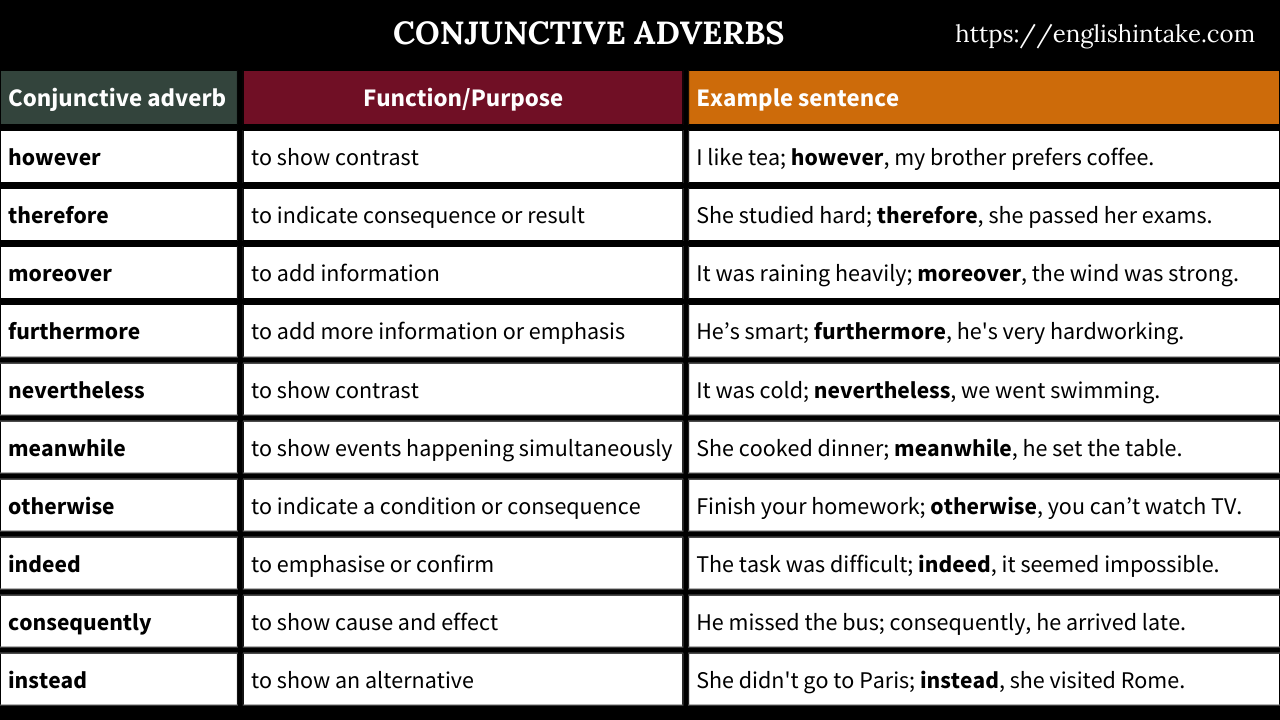1. What are conjunctive adverbs?
In English, conjunctive adverbs are transitional words that connect independent clauses, showing relationships between ideas. They function as both adverbs and conjunctions They function as both adverbs and conjunctions. Their use in sentences helps improve clarity, coherence, and logical flow.
Here is a list of common conjunctive adverbs in English:
- accordingly
- also
- besides
- anyway
- certainly
- consequently
- furthermore
- finally
- hence
- however
- incidentally
- instead
- indeed
- likewise
- thus.
- moreover
- meanwhile
- next
- nevertheless
- nonetheless
- similarly
- otherwise
- subsequently
- still
- therefore
- then
Conjunctive adverbs have four key characteristics that enhance the clarity and flow of your writing:
Connect two independent clauses:She studied hard; however, she did not pass the exam.
Show logical relationships (contrast, cause-effect, sequence):The candidate promised extensive reforms; however, his policies remained largely unchanged after the election.
Require specific punctuation:When connecting independent clauses, a semicolon is placed before the adverb and a comma after it. The road was closed for repairs; therefore, commuters had to take a detour.
Can move within clauses:Their placement is flexible without changing the meaning. Original sentence: "He is an excellent strategist; indeed, he led the campaign to success." Alternative placements: "Indeed, he is an excellent strategist; he led the campaign to success." or "He is, indeed, an excellent strategist; he led the campaign to success."
⚠ Avoid using just a comma to link two independent clauses with a conjunctive adverb, as this causes a comma splice!
2. Different categories of conjunctive adverbs
Conjunctive adverbs can be categorised into different groups based on their function in a sentence. The table below illustrates this.
Contrasthowever, nevertheless, nonetheless, still
Show opposition or unexpected results
Additionfurthermore, moreover, also, besides
Add similar or supporting information
Cause and Effecttherefore, thus, consequently, as a result
Show reasons, results, or consequences
Comparisonlikewise, similarly, in the same way
Show similarity or likeness
Examplefor example, for instance, such as, namely
Provide specific instances or illustrations
Emphasisindeed, in fact, of course, above all
Highlight or stress key points
Timethen, meanwhile, afterward, subsequently
Show sequence or timing of events
Summaryin conclusion, to sum up, overall, in short
Summarize or conclude ideas
2.1. Addition
To add extra information or reinforce a previous statement, the following conjunctions can be used:
Also – She loves reading; also, she enjoys painting.
Besides – We can’t go to the park; besides, it’s raining.
Furthermore – The plan is too expensive; furthermore, it’s impractical.
Moreover – The hotel was beautiful; moreover, it had excellent service.
Likewise – She enjoys hiking; likewise, her brother loves outdoor activities.
2.2. Contrast
To highlight contradictions between two ideas, signal opposing viewpoints or unexpected outcomes within a sentence, the following words can be used.
However – The book was long; however, it was very interesting.
Nevertheless – The task was difficult; nevertheless, she completed it on time.
Nonetheless – It was cold outside; nonetheless, they went for a walk.
Instead – I didn’t go to the party; instead, I stayed home and watched a movie.
Still – He was tired; still, he continued working.
2.3. Cause and effect
Sometimes, we need to show the relationship between an action and its consequence to clarify why something happened or what resulted from a particular event. In this case, we can use the following conjunctive adverbs.
Consequently – He forgot to set his alarm; consequently, he was late for work.
Hence – She studied hard; hence, she passed the exam with flying colors.
Thus – The road was blocked; thus, we had to take a detour.
Therefore – He didn’t pay the bill; therefore, his electricity was cut off.
2.4. Time
This category includes conjunctive adverbs that indicate the order in which events or actions occur. They are essential for structuring narratives and organising steps in a logical sequence.
Meanwhile – John was cooking; meanwhile, Sarah set the table.
Next – We finished dinner; next, we went for a walk.
Finally – He worked hard all year; finally, he got the promotion.
Subsequently – The company made a bad investment; subsequently, it faced bankruptcy.
Then – She packed her bags; then, she left for the airport.
2.4 Emphasis
The following words strengthen a statement, add certainty, or draw attention to a specific point. They help reinforce the writer’s argument or clarify an important detail.
Certainly – She is certainly the most talented dancer in the group.
Indeed – The meal was indeed delicious.
Incidentally – Incidentally, I met your cousin at the mall yesterday.
Anyway – It was a bad idea; anyway, we tried it.
Otherwise – Study hard; otherwise, you might fail the exam.
3. Common errors & corrections
| Incorrect | Reason | Correct |
|---|---|---|
| I was tired, however I stayed awake. | Missing semicolon | I was tired; however, I stayed awake. |
| She studied hard. Consequently, she passed. | Run-on sentence | She studied hard; consequently, she passed. |
| Although it was late, moreover we continued. | Double conjunction | Although it was late, we nevertheless continued. |

